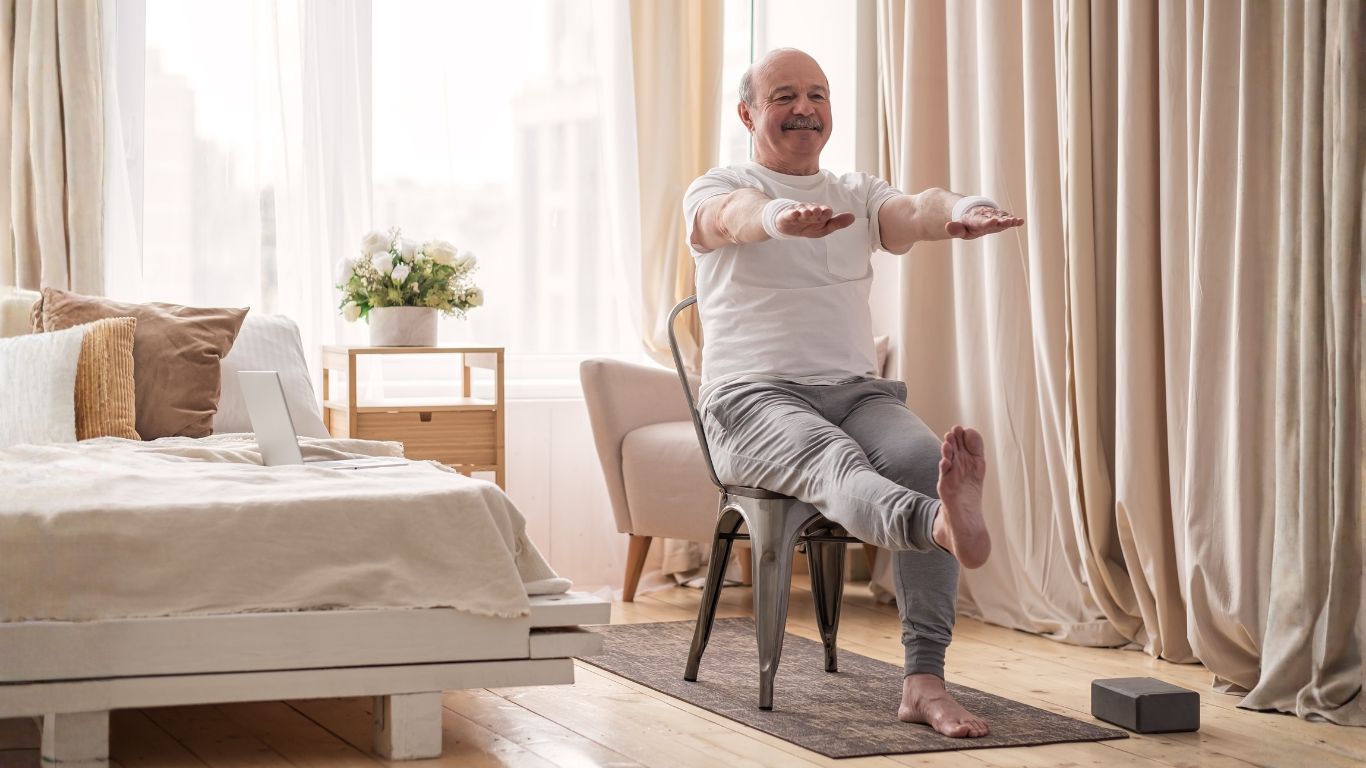Seniors can enhance their strength, flexibility, and mobility with chair exercises while lowering their chance of falling. The following are specific instructions for some of the most helpful chair activities, which are intended to improve general fitness by targeting important muscle groups.
Best Chair Exercises for Seniors: Step-by-Step Guide
1. Sit-to-Stands (Chair Squats)
Strengthens legs and improves balance for daily activities.
Steps:
- With your feet flat on the ground and your shoulders at a comfortable distance, sit close to the front edge of the chair.
- For balance, either extend your arms out in front of you or cross them over your chest.
- With a straight back, lean forward a little.
- Stand up straight while pushing yourself through your heels.
- Gently lower yourself back down with control.
- Do it 10–15 times.
2. Seated Hip Stretch
Improves hip flexibility and reduces knee pain.
Steps:
- Maintain an erect posture with your spine straight.
- Make a triangle by crossing your right ankle over your left knee.
- Lean forward a bit while maintaining a straight back until you experience a stretch in your hip.
- Maintain for 15 to 30 seconds without discomfort.
- Resume sitting and change your legs.
- Do it two to three times on each side.
3. Extended Leg Raises
Strengthens core and leg muscles.
Steps:
- Stay close to the edge of the chair with your back straight.
- Place your right leg straight out in front of you with your toes pointing up.
- For support, use your hands to grip the chair’s seat.
- Aim for hip height as you slowly raise your right leg as high as it can go.
- Lower it gradually.
- Repeat 10–15 times, then switch legs.
4. Seated Torso Twists
Enhances core strength and spinal mobility.
Steps:
- Keep your arms folded over your chest, your feet flat on the ground, and your posture erect.
- While keeping your hips facing forward, gently twist your upper body to the right as far as it feels comfortable.
- Hold for 2–3 seconds before coming back to the middle.
- Turn to the left and hold.
- Do this ten times on each side.
5. Seated Calf Raises
Strengthens lower legs to improve walking and balance.
Steps:
- Knees should be bent at 90 degrees, and your feet should be flat on the ground.
- To raise your heels off the floor as high as you can, push down through your toes.
- Maintain for a moment before lowering your heels.
- Repeat 15 to 20 times.
6. Chair Planks (Modified)
Builds core and upper body strength safely.
Steps:
- Position your hands on the seat next to your hips or on the armrests while seated close to the chair’s edge.
- Using your hands, press down and raise your hips a little bit off the chair, activating the muscles in your core.
- Maintain the posture for 10–20 seconds.
- Slowly lower down.
- Do this three to five times.
7. Reverse Fly
Targets the upper back and shoulders to improve posture.
Steps:
- With a water bottle or light dumbbell in each hand, maintain an upright posture.
- Hold your arms out in front of you at shoulder level, with the palms facing each other.
- Squeeze your shoulder blades together as you extend your arms out to the sides while maintaining a little bend in your elbows.
- Return to the beginning position gradually.
Best Chair Flexibility Exercises for Seniors: Step-by-Step Guide
Seniors must increase their flexibility in order to preserve mobility, lessen stiffness, and improve their comfort throughout the day. Chair stretches are one of the safest and most enjoyable hobbies for seniors to expand their range of motion without added stress.
Here are thorough instructions for some of the most productive seated flexibility workouts.
1. Seated Shoulder Stretch
Enhances shoulder flexibility and eases stiffness.
Steps:
- Keep your back and shoulders relaxed as you sit up straight.
- At shoulder height, stretch your right arm directly across your chest.
- To increase the stretch, gently bring your right arm closer to your body using your left hand.
- Feel the tension in your shoulder and upper arm as you hold for 30–60 seconds.
- Release, then repeat on the other side.
2. Seated Hamstring Stretch
Improves flexibility in the back of the thigh and reduces lower back tension.
Steps:
- With your right leg stretched out straight, heel on the floor, and toes pointing up, sit close to the edge of your seat.
- From your hips, bend forward softly toward your extended leg while maintaining a straight back.
- Stop when you experience a pleasant stretch in your hamstring (rear of the thigh).
- Change legs and go back to your starting place.
- Do this 2–3 times for each leg.
3. Seated Neck Rotation
Increases neck mobility and relieves tension.
Steps:
- Sit upright with your shoulders relaxed and your feet flat on the floor.
- Look over your shoulder as far as is comfortable, slowly turning your head to the right.
- Feel the stretch along the side of your neck as you maintain the position for 10 seconds.
- Go back to the middle and do the same thing on the left side.
- Do three to five reps on each side.
4. Seated Marches
Improves hip flexibility and promotes circulation.
Steps:
- Keep your feet flat on the floor, sit up straight, and keep your hands on your lap or the arms of your chair.
- Raise your right knee as high as you can in the direction of your chest.
- Bring your foot back down to the ground.
- Do the same with your left leg.
- For 20 to 30 reps, maintain a marching motion while switching legs.
5. Seated Chest Stretch
Opens the chest and improves posture.
Steps:
- Keep your feet flat on the ground and your back straight while sitting.
- If at all possible, clasp your hands behind your back with your palms pressed together.
- Squeeze your shoulder blades together and softly straighten your arms.
- Maintain the stretch for 20 to 30 seconds while lifting your chest just a little bit.
- Let go, then do it again two or three times.
6. Seated Forward Bend
Stretches the lower back and hamstrings.
Steps:
- With your feet level on the floor and about hip-width apart, sit on the edge of your seat.
- Slowly bend forward from your hips, extending your hands toward your feet or the ground.
- Relax your neck and maintain your back as straight as you can.
- Feel the stretch in your lower back and legs as you maintain it for 20–30 seconds.
- Gradually return to the starting position.
- Do it two or three times.
What are the Benefits of Chair Workouts?
Chair workouts offer numerous advantages, especially for seniors and individuals with limited mobility. Here are the key benefits supported by research and expert insights:
- Establish Strength Safely: A 2021 systematic review of 25 studies with 1,388 older adults revealed that chair-based exercise programs significantly enhanced upper limb strength (handgrip strength and arm curl tests) and lower limb function.
- Enhance Joint Flexibility and Mobility: Chair exercises help maintain joint mobility and reduce stiffness. This is an important part of physical disability support at home for older adults to maintain function and lower the risk of falls.
- Boost Stability and Balance: According to studies, combining chair aerobics with coordination exercises improves balance and coordination in older adults.
- Improve Cardiovascular Health and Circulation: Aerobic chair exercises performed while sitting have been proven to boost circulation and cardiovascular fitness, thereby promoting heart health with little effect on the joints.
- Suitable for All Fitness Levels: Because chair workouts are flexible and inclusive, they are appropriate for seniors with a variety of mobility levels and persistent ailments, which encourages greater involvement.
- Encourage Cognitive Health: In older individuals, consistent physical exercise, such as chair-based routines, is linked to better mental health and slower cognitive deterioration.
- Lower Stress and Boost Mood: Group chair exercise programs address the loneliness and depression that are prevalent among older people by promoting social interaction and emotional wellbeing.
- Aid in Counteracting Age-Related Muscle Loss: Chair workouts are a type of resistance training that aids in the fight against sarcopenia by maintaining muscle mass and strength, both of which are vital for older individuals’ mobility and health.
Conclusion
Chair workouts are a powerful and accessible way for seniors and individuals with limited mobility to improve their strength, flexibility, balance, and overall wellbeing. With simple equipment and minimal risk, these exercises can be performed at home or in group settings, making fitness achievable for everyone.
Call us today at 0161 428 1989 to speak directly with a care coordinator or visit True Homecare to request a free, no-obligation consultation. Our team supports your journey to better health with accessible fitness solutions like chair workouts.
FAQs
1. Can arthritis or joint pain be treated with chair exercises?
Chair workouts are indeed gentle on the joints and have a low impact. They can be modified for arthritis, but you should speak with your doctor before beginning.
2. If I fatigue quickly, how long should I work out?
Start with 5 to 10 minutes and increase gradually. Pay attention to your body and take breaks as necessary.
3. What can I do if I don’t have dumbbells?
Use common household objects for resistance, such as water bottles or canned foods, or use your body weight.
4. Is it possible for me to do chair exercises if I have balance problems?
Use a sturdy, non-wheeled chair, keep your feet flat, and if necessary, have assistance available.



